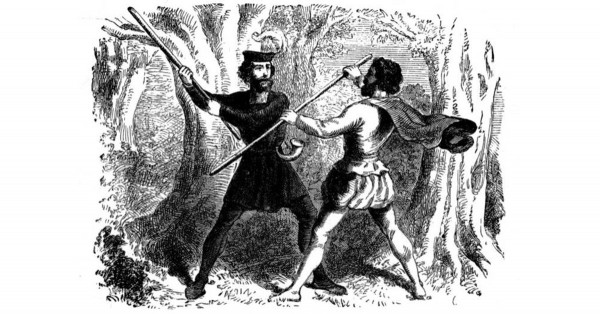In virtually every part of the world the long stick was or is used as a weapon. In earlier centuries, it was mainly preferred by the poorer rural population, because farmers could not afford blade weapons. But a long walking stick was quickly at hand when danger arose. This is how Bo-Jitsu, the art of fighting the Bo, was born in Japan. And in China several traditional fighting styles use the long staff, which is called Gun there. In the Philippines the long stick Bangkaw originated from the hunting spear of the indigenous tribes. The European traditions are comparatively little known today - for example the English Quarterstaff.
The English Quarterstaff
In the early modern period, i.e. the epoch after the discovery of America, there was already a lively exchange among the fencing masters of Europe. Different schools argued about whose style was the most effective. The English nobleman George Silver (around 1550 - around 1620) was not a fencing master himself, but as an author he had strong opinions on the subject. In 1599 his influential treatise on martial arts called "Paradoxes of Defense" was published. In it he criticized fencing schools, which at that time made a furore on the continent. Especially the Rapier wasn't to his liking at all. This thin sword weapon spread from Italy and Spain all over Europe. The fact that the Italian Rapier fencing masters Rocco Bonetti and Vincentio Saviolo now even began opening schools in his hometown of London was a real blow to Silver.
Besides, in his book George Silver described the fighting style with the long stick, which was called "Quarterstaff" in England. The handling of the baton should be based on the same method as that of other pole weapons, such as the spear or the halberd, the author wrote. But also the two-handed sword would be handled very similarly. Anyhow, Silver saw the long stick as an excellent weapon. In this, he agreed with other authors of his time, such as the Scot Donald McBane or the Englishman Joseph Swetnam.
The Guild of Masters
Svetnam belonged to the Company of Maisters of the Science of Defence, the guild of English fencing masters. This organization had been founded a few decades earlier under the reign of Tudor King Henry VIII. Similar to the craft guilds, the Company of Masters had obtained a monopoly from the Crown. Only they were allowed to train fencing masters and issue licenses. All members had to follow strict rules and were incorporated into a hierarchy. In this way, quality and control were to be ensured in the same way.
The public examinations of the Fencing Masters' Guild were particularly popular with the London population. In "Prize Playing", a master student competed against several opponents one after the other. The fights were hard, but not in a way that would be called "full contact" today. Like in a sparring match, the fighters proved their abilities without really hitting their opponents hard or knocking them out. There was no protective equipment. It was forbidden to strike below the waist, but stikes to the head were allowed. The weapons used were a blunt Basket Sword or Rapier, but also the Quarterstaff was common. The audience could watch the test and cheer on their favourites.
On the way to modernity
In the 18th century, these noble events developed into the much coarser "Prize Fights". These popular happenings rather resembled gladiator fights. They offered a bloody spectacle, sometimes including fatalities. In these competitions the opponents competed against each other more and more often without weapons over the course of time, in the end they completely discarded them. This basically led to English Boxing. The famous fistfighter James Figg (1684-1737) is widely regarded as the first champion in Bare Knuckle, the fight without gloves. But Figg was also a champion of stick fighting and mastered the Quarterstaff. Over time, Boxing was tamed by rules. It developed into a sport that particularly appealed to the lower classes of society.
But also the fight with the long pole continued to exist. In the late 19th century several fencing schools in England taught a modernized version. The students predominantly came from the upper classes. The military academy in Aldershot, Hampshire, in southern England, also taught how to use the Quarterstaff. The students wore protective equipment similar to that used in fencing. Beside the long staff the English stick fencers also knew the Singlestick, a one-handed led stick with hand protection. However, it was not necessarily seen as a fully-fledged weapon, but mainly used for the safe practice of sword fighting techniques.
The Quarterstaff was not the only long staff fighting style in Europe. Practically at the same time the style of the Cannes de Combat came into being in France and the Jogo do pau was developed in Portugal. Today different organizations work to revive the old martial arts of Europe. On the basis of the handwritings of the old masters and their artistic illustrations they reconstruct the old technique as well as possible and put it into practice.
You can find excellent long staffs for your training in our webshop.
Photo: Gutenberg Project

